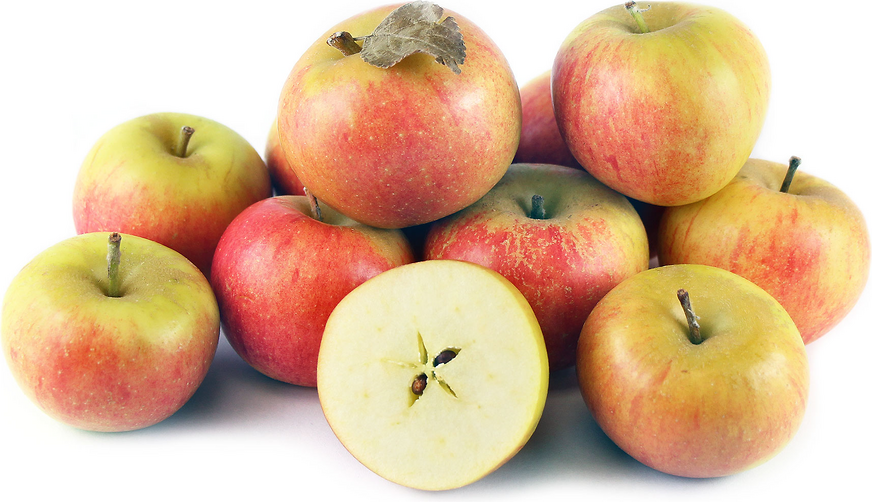


Lamb Abbey Apples
Estimated Inventory, lb : 0
Description/Taste
Lamb Abbey apples are small fruits with a round to oblate shape and are connected to fibrous, green-brown stems. The skin is waxy and firm with a yellow-green base, covered in striping and patches of red blush. The skin also bears light ribbing, brown russeting around the base of the stem, and prominent white pores known as lenticels scattered across the surface. Underneath the skin, the flesh is cream-colored, crisp, dense, semi-coarse, and juicy, encasing a central core filled with small, dark brown seeds. Lamb Abbey apples are crunchy and aromatic with a sweet-tart, acidic flavor followed by subtle notes of pineapple.
Seasons/Availability
Lamb Abbey apples are available in the fall through early winter.
Current Facts
Lamb Abbey apples, botanically classified as Malus domestica, are a rare heirloom variety that belongs to the Rosaceae family. The small apple cultivar is over two hundred years old and was a spontaneous mutation of the Newport pippin, an American apple introduced into England. Lamb Abbey apples are named after Lamb Abbey in Kent, England, where the apple was initially discovered. Also known as a Lamb Abbey Pearmain, Lamb Abbey apples were one of the first English varieties to have been created from an American apple and were widely popular as a home garden cultivar in the 19th century. Despite their unique, sweet, and tangy taste, the variety’s small size was not suited for commercial production, causing it to fall from popularity quickly. The apple became relatively unknown for many years, only cultivated as a specialty item in gardens, but then developed a renewed interest after a revival of heirloom apples in the mid-20th century.
Nutritional Value
Lamb Abbey apples are a good source of vitamin C and dietary fiber, which can help regulate the digestive tract. The apples also provide some antioxidants, which help maintain overall health, and contain potassium and vitamin A.
Applications
Lamb Abbey apples are best suited for raw applications as their balanced flavor is showcased when consumed fresh, out-of-hand. The variety is considered a dessert apple and can be eaten as a stand-alone snack or served with cheeses, nuts, dips, and other fruits. Lamb Abbey apples can also be sliced and tossed into green and fruit salads, pressed into juices and ciders, or dipped in chocolate as a crunchy sweet. In addition to fresh applications, the apples can sometimes be baked into pies, blended into sauces, cooked with cinnamon, or stewed and served with roasted meats. Lamb Abbey apples pair well with herbs such as rosemary, thyme, and parsley, crème fraiche, romaine, arugula, grapes, and nuts such as pine nuts, hazelnuts, almonds, or walnuts. The fresh apples will keep 1-4 weeks when stored in the crisper drawer of the refrigerator.
Ethnic/Cultural Info
Lamb Abbey apples are a part of the United Kingdom’s National Fruit Collection, which is one of the largest assortments of different fruit varieties in the world. It has been reported that the collection holds over 3,500 different cultivars of apples, cherries, plums, pears, and other fruits. The purpose of the National Fruit Collection is to store unique cultivars to protect genetic diversity and to use them for future breeding. Many of the varieties saved into the collection, such as Lamb Abbey apples, exhibit quality growth characteristics, unusual flavors, and memorable, aesthetic appearances.
Geography/History
Lamb Abbey apples are a spontaneous mutation that occurred by chance on a Newport pippin apple tree in 1804. Mary Malcomb first noticed the apple growing on one of her trees at her home at Lamb Abbey in Kent, England, and after its discovery, the variety was widely cultivated across the United Kingdom. In 1819, the Horticultural Society of London awarded Malcolm a medal for contributing to the discovery and cultivation of the new variety. Today Lamb Abbey apples are still grown in home gardens in the United Kingdom and are also grown through specialty growers in Europe and the United States.
Recipe Ideas
Recipes that include Lamb Abbey Apples. One
| Giadzy |
|
Raw Apple, Fennel, and Carrot Spiralized Salad |
| The Rawtarian |
|
Raw Vegan Chicken Salad |




